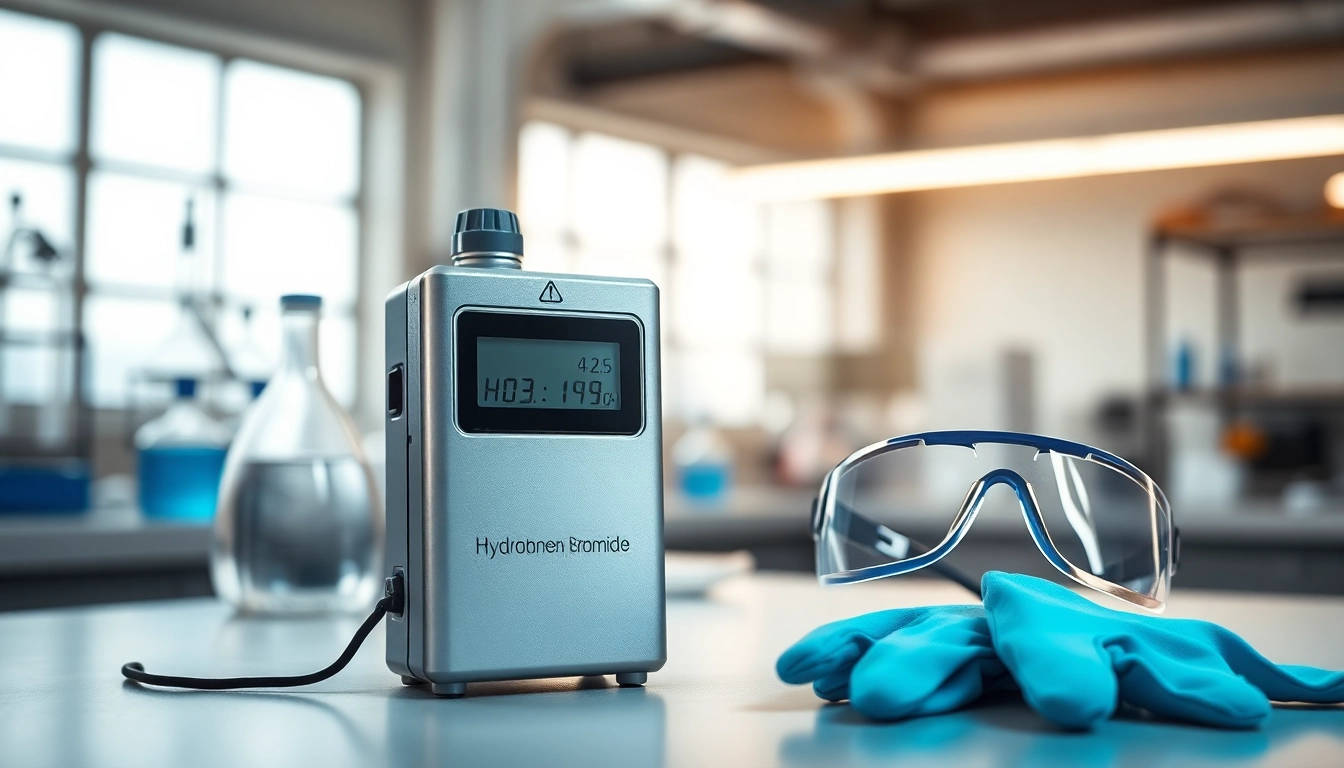Understanding Hydrogen Bromide: Properties and Risks
What is Hydrogen Bromide?
Hydrogen bromide is a colorless, corrosive gas with a pungent, irritating odor. When dissolved in water, it forms hydrobromic acid, a strong acid recognized for its reactivity and hazardous nature. Hydrogen bromide (HBr) is produced primarily through the reaction of bromine with hydrogen, making it an important compound in various industrial applications. Its chemical structure consists of a bromine atom covalently bonded to a hydrogen atom, which contributes to its reactivity and toxicity.
Common Applications and Use Cases
Hydrogen bromide is utilized across a multitude of industries for various purposes. Key applications include:
- Synthesis of Bromine Compounds: HBr is significant in producing numerous organic and inorganic bromine compounds that serve as intermediates in pharmaceutical and agrochemical manufacturing.
- Environment Assessment: The compound is employed to measure and analyze bromine levels in environmental studies, benefiting sectors concerned with pollution control and waste management.
- Water Treatment: Hydrogen bromide is sometimes used in water treatment processes to control biological growth and contribute to sanitation efforts, particularly in large-scale systems.
These applications underscore the importance of understanding and monitoring hydrogen bromide levels to ensure safety and efficacy in its use.
Health Hazards of Hydrogen Bromide Exposure
Exposure to hydrogen bromide can pose serious health risks. Inhalation of its vapors may lead to respiratory issues, including irritation of the throat, lungs, and eyes. Symptoms can range from mild discomfort to severe bronchial spasms and pulmonary edema. Prolonged exposure might result in chronic respiratory conditions or chemical pneumonitis. Additionally, contact with skin or mucous membranes can lead to corrosive burns, necessitating immediate medical attention.
Given these hazards, implementing effective detection and monitoring systems is crucial, especially in environments where hydrogen bromide is stored or used.
Importance of Hydrogen Bromide Detectors
Why You Need a Hydrogen Bromide Detector
Hydrogen bromide detectors are indispensable devices in industries where this compound is present. Their primary function is to continuously monitor HBr concentrations in the air, providing early warnings of potential leaks or hazardous exposure levels. This monitoring capability is critical for maintaining the safety of personnel, protecting facilities, and ensuring compliance with regulatory standards.
Investing in reliable Hydrogen Bromide detectors also enhances operational efficiency, as unwarranted shutdowns or costly leaks can be avoided through proactive detection strategies.
Key Features to Look for in a Detector
When selecting a hydrogen bromide detector, it is crucial to consider certain key features that ensure optimal performance:
- Sensitivity and Range: The detector should be sensitive enough to identify low levels of hydrogen bromide, as well as have a wide detection range to cover expected concentrations in various environments.
- Response Time: Fast response times are essential for safety, allowing for the immediate identification of leaks which could pose serious risks.
- Durability: Given the corrosive nature of HBr, the detector should be constructed from materials resistant to chemical corrosion.
- Calibration and Maintenance Features: Users should consider devices that offer easy calibration and maintenance routines to ensure ongoing accuracy.
Regulatory Standards and Compliance
Regulatory bodies, including OSHA and EPA, have established standards regarding exposure limits for hydrogen bromide in occupational settings. Compliance with these standards is critical not just for legal adherence, but also for the health and safety of employees. Regular monitoring with hydrogen bromide detectors aligns with these regulations, providing documentation and evidence of safety practices. Furthermore, understanding these standards aids in maintaining a safe work environment while minimizing liability risks for companies.
Types of Hydrogen Bromide Detectors Available
Portable vs. Fixed Hydrogen Bromide Detectors
Hydrogen bromide detectors can be classified into two main categories: portable and fixed detectors. Each type serves distinct applications based on the specific needs of the user.
Portable Detectors: These handheld devices are flexible and can be taken to different locations, making them ideal for fieldwork, inspections, or smaller work environments. They provide immediate readings and can be used to spot-check areas for leaks.
Fixed Detectors: Installed in strategic locations, fixed detectors provide continuous monitoring in designated areas, such as production facilities or labs. These systems can trigger alarms when set thresholds are crossed, providing a safety net around hazardous areas.
Sensor Technologies in Hydrogen Bromide Detection
Various sensor technologies are employed in hydrogen bromide detection:
- Electrochemical Sensors: These sensors use a chemical reaction to detect the presence of hydrogen bromide and provide real-time measurements, making them suitable for portable detectors.
- Infrared Sensors: These utilize infrared light absorption to measure the concentration of gases, including hydrogen bromide. They are useful for fixed installations due to their durability in various environmental conditions.
- Metal Oxide Sensors: These sensors utilize a sensing element that changes its resistance in the presence of hydrogen bromide, offering an effective means for detecting low concentrations of gas.
Each of these sensor technologies has its advantages and disadvantages, requiring careful consideration based on the specific application and environment where the detector will be used.
Comparison of Top Hydrogen Bromide Detector Models
When considering specific models of hydrogen bromide detectors, a few stand out based on performance, features, and user reviews:
- Model A: This portable detector offers rapid response times and is equipped with a highly sensitive electrochemical sensor, making it ideal for spot-checking. It features advanced data logging capabilities.
- Model B: A fixed detector designed for industrial applications, featuring a robust infrared sensor that can withstand harsh environments while providing continuous monitoring.
- Model C: Known for its exceptional calibration capabilities, this model is suited for laboratories requiring precise and consistent monitoring of hydrogen bromide levels.
Assessing the specific functionality and suitability of these models can guide users in selecting the right equipment for their needs.
Installation and Maintenance of Hydrogen Bromide Detectors
Best Practices for Installing Your Detector
Proper installation of hydrogen bromide detectors is crucial for ensuring their effectiveness. Here are best practices to follow:
- Location: Install detectors in areas where hydrogen bromide is likely to accumulate, such as near storage tanks or processing areas. High-risk zones should be prioritized based on airflow patterns and potential leak points.
- Height: For fixed detectors, place them at an appropriate height where the gas is most likely to be detected. Because hydrogen bromide is heavier than air, positioning them lower may be beneficial.
- Calibration: Ensure that detectors are calibrated according to the manufacturer’s instructions and industry standards after installation.
Routine Maintenance Checklist
Routine maintenance is essential to ensure the long-term operation and accuracy of hydrogen bromide detectors. A checklist may include:
- Regular calibration to ensure accuracy
- Cleaning the sensor and housing components
- Testing the alarm and response systems
- Inspecting all power sources and batteries
- Documenting service records for compliance and safety audits
Troubleshooting Common Issues with Detectors
Even with proper care, issues may arise with hydrogen bromide detectors. Common problems can include false alarms, failure to respond, or inaccurate readings. Troubleshooting steps should include:
- Checking for sensor contamination or accumulation of dust/debris.
- Reviewing the calibration settings and recalibrating if necessary.
- Inspecting wiring and connections for any signs of damage.
- Consulting the manufacturer’s guidelines for specific troubleshooting steps.
Ensuring Safety in the Workplace with Hydrogen Bromide Detectors
Training Staff on Detector Usage
Effective training programs should be established to ensure that staff can competently use hydrogen bromide detectors. Training should cover:
- Operation instructions: Understanding how to read and interpret readings.
- Emergency procedures: Knowing how to respond to alarm signals to ensure safety.
- Maintenance duties: Training on basic care routines and reporting related issues.
Creating a Safety Protocol with Detection Systems
Integrating hydrogen bromide detectors into a comprehensive safety protocol enhances workplace safety significantly. Such protocols should include regular monitoring schedules, guidelines for responding to detector alerts, and protocols for safe evacuation procedures in case of a detected leak.
Evaluating Detector Performance and Effectiveness
Regular evaluations of detector performance are critical for ongoing safety and compliance. Consider conducting regular assessments that include:
- Data review: Analyzing incident reports related to alarms and calibrations.
- Performance metrics: Comparing actual safety performance against industry benchmarks.
- Feedback surveys: Gathering input from staff on detector usability and effectiveness.
This systematic approach ensures that detectors remain effective and are used as part of a comprehensive safety strategy.



